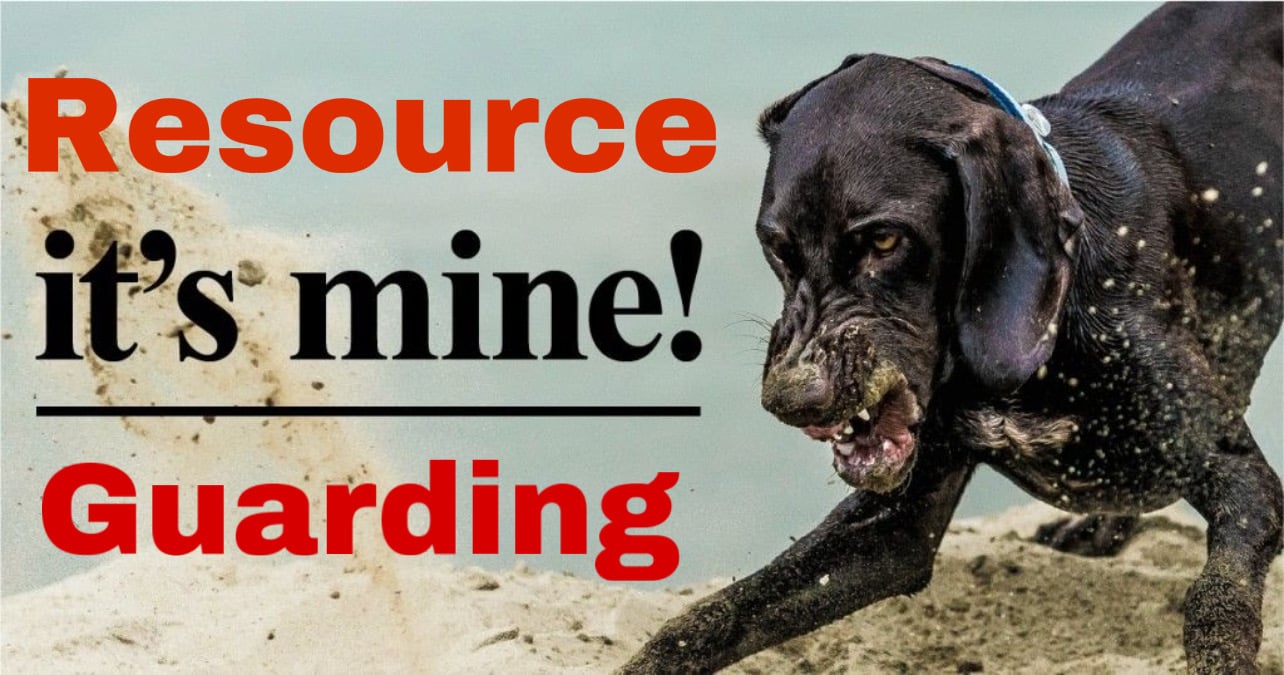Food Aggression, resource guarding, Territorial Aggression, Toy Aggression
How to Prevent and Manage Resource Guarding.
How to Prevent and Manage Resource Guarding by Will Bangura, M.S., CBCC-KA, CPDT-KA,
(Dog Behaviorist) Certified Behavior Consultant.
Resource guarding is a common behavior in dogs that can be observed in various forms. It occurs when a dog perceives a particular item, area, or individual as valuable and feels threatened by the prospect of losing it. Resource guarding can be dangerous if unchecked, leading to aggressive displays such as growling, snapping, or biting. This article will discuss the different types of resource guarding and the potential causes and contributing factors of this behavior.
Types of Resource Guarding.
Food Guarding.
Food guarding is one of the most common types of resource guarding in dogs. It occurs when dogs behave aggressively around their food bowl, treats, or other edible items. Dogs may growl, snap, or bite when someone approaches them while eating or attempting to take their food away.
Toy Guarding.
Dogs may also display resource-guarding behavior around their toys or other playthings. They may growl, snap, or become possessive when someone tries to take their toys away.
Space Guarding.
Dogs may also guard particular areas, such as their bed or crate, and may display aggressive behavior when someone tries to approach or enter that space.
Furniture Guarding.
Some dogs might guard furniture, for example, a couch or a chair. The dog may become aggressive if someone tries to move them from their spot.
People Guarding.
Dogs may also guard specific people, such as their owner or a family member, and become aggressive when someone approaches them.
Pet Guarding.
Dogs may also display resource-guarding behavior around other pets in the household. They may growl, snap, or become aggressive when another animal approaches their food or toys.
Click Image Above here to Buy on Amazon
Causes and Contributing Factors of Resource Guarding.
Early Development in the Litter.
A dog’s early development can influence resource guarding in the litter. Puppies that grow up in large litter may need to compete for resources, such as food and space, and may learn to be possessive of these resources to ensure their survival. This early experience may lead to resource-guarding behavior in adult dogs.
Critical Socialization Periods.
Socialization is critical for puppies to develop into well-adjusted adults. The socialization period for dogs starts at about three weeks and ends at 14 weeks. All puppies must be exposed to as many people, dogs, places, smells, sights, things, and environments as possible to learn how to interact and communicate with the world around them without fear, anxiety, or aggression. . Failure to provide proper socialization during this period may lead to a lack of confidence and increase the risk of resource guarding.
Pet Parents’ Interaction with Resources.
How pet parents interact with their dogs’ resources can also contribute to resource-guarding behavior. For example, if a pet parent often takes away a dog’s toy or food, the dog may learn to be possessive and protective of those resources. If a pet parent always gives their dog access to food and toys, the dog may not learn to share them and might become more possessive.
Medical Contributing Factors.
Some medical conditions may also contribute to resource-guarding behavior in dogs. For example, a neurochemical imbalance, such as low serotonin levels, may increase the risk of aggression and resource guarding. Pain or discomfort caused by a medical condition may also contribute to resource-guarding behavior.
Breed Predisposition.
Some breeds may be more predisposed to resource-guarding behavior than others. Breeds originally bred for guarding or protection, such as Dobermans or Rottweilers, may be more likely to display resource-guarding behavior.
Tips on How to Prevent and Manage Resource Guarding.
Preventing Resource Guarding.
Preventing resource guarding requires early socialization, training, and management. Exposing your puppy to various people, dogs, and environments during the critical socialization period is essential. Positive reinforcement training can also help prevent resource-guarding behavior by teaching your dog to share and not be possessive of its resources. Managing your dog’s resources is essential by providing them with space, toys, and food bowls.
Preventing resource-guarding behavior is essential to avoid any potential aggression or injury. The following are some steps that can be taken to prevent resource-guarding behavior in dogs:
Start Early Socialization.
Early socialization and exposure are critical for puppies to learn how to interact with the world around them without developing fears and anxiety. . Introducing puppies to various people, animals, and environments during socialization can help prevent resource-guarding behavior. Socialization should be a positive and rewarding experience for puppies.
Teach Proper Resource Sharing.
Teaching dogs to share their resources is essential to prevent resource-guarding behavior. Encouraging dogs to share their food, toys, and space with other dogs or people can help prevent possessiveness and aggression.
Use Positive Reinforcement.
Positive reinforcement is an effective way to train dogs and reinforce good behavior. Rewarding dogs with treats or praise when they display good behavior, such as sharing their resources or allowing others to approach their food bowl, can encourage positive behavior and discourage resource guarding.
Use Desensitization Techniques.
Gradual desensitization to triggers that may lead to resource guarding can effectively prevent the behavior. For example, gradually introducing other dogs or people to a dog’s food bowl or toys can help them learn to be less possessive of their resources.
Managing Resource Guarding.
Managing resource guarding requires a multifaceted approach that includes training, socialization, and management. Working with a professional trainer or dog behaviorist is crucial to creating a tailored dog plan. Plans should include positive reinforcement training, like teaching your dog to drop a toy on command, and desensitization techniques, to gradually introduce your dog to other dogs or people in a controlled environment.
Until the behavior modification work has been done, it is essential that the first step is to avoid all triggers. This is not the “fix” but the first step to the “fix.”
How to Prevent and Manage Resource Guarding by Avoiding Triggers.
How to Avoid Triggers for Resource Guarding.
Food.
The best way to avoid triggers for food guarding is to feed your dog in a crate or in a quiet, calm environment where they won’t feel threatened. Feed the dogs in a crate where they won’t be disturbed by a dog or person. Additionally, avoid interrupting your dog’s meal or taking away their food while they’re eating.
Toys.
To avoid triggers for toy guarding, give each of your pets their toys to play with and avoid toys that may cause competition or aggression, such as tug toys. Additionally, supervise playtime and separate pets that show aggressive behavior towards each other.
Territory.
To avoid territorial triggers, ensure your dog has a designated space where they feel safe and secure, such as a crate or bed. Train your dog to go to its designated space when they need to rest or feels threatened.
People.
To avoid triggers for human guarding, teach your dog to respect personal space and boundaries. Encourage your dog to sit or lay down when someone approaches, and reward calm behavior. Additionally, provide enough attention and affection to all pets to avoid competition for attention.
Other dogs or animals.
To avoid triggers for dog-to-dog resource guarding, feed your pets in separate rooms or crates, and supervise playtime to prevent aggressive behavior. Train your pets to respect each other’s personal space and boundaries.
Examples of Avoiding Triggers for Resource Guarding.
Food.
If your dog is food guarding, avoid feeding them around other pets or humans. Feed them in a separate room or crate where they can eat undisturbed. Additionally, consider feeding them smaller meals throughout the day instead of one large meal to reduce the stress and anxiety associated with meal times.
Toys.
If your dog is guarding their toys, provide each of your pets with their toys and avoid tugging toys that encourage competition or aggression. Additionally, supervise playtime and separate pets that exhibit aggressive behavior towards each other.
Territory.
Dogs that show signs that it is territorial over their space must be provided with their own space where they feel safe and secure, like a crate or bed. Train your dog to go to its designated space when they need to rest or feels threatened. Also, avoid disturbing your dog when in their designated space, and teach other pets and people to respect your dog’s personal space.
People.
If your dog is possessive of their humans, teach them to respect personal space and boundaries. Encourage your dog to sit or lay down when someone approaches and reward calm behavior. Additionally, provide enough attention and affection to all pets to avoid competition for attention.
Other dogs or animals.
If your dog exhibits resource guarding towards other pets, feed them in separate rooms or crates and supervise playtime to prevent aggressive behavior. Additionally, train your pets to respect each other’s personal space and boundaries and separate them when necessary.
Managing resource guarding is important in ensuring your pets’ and family’s safety and well-being. By avoiding triggers for resource guarding, you can prevent aggressive behavior and create a peaceful and safe environment for all your pets. Additionally, always prioritize safety and take necessary precautions to prevent dangerous situations. With patience, consistency, and proper training, you can effectively manage resource guarding and create a harmonious living environment for your pets.
If a dog already displays resource-guarding behavior, it is best to seek professional help to address the behavior. A professional dog trainer or a dog behaviorist can help guide how to modify the behavior and prevent it from escalating into aggression.
Resource guarding is a typical dog behavior that can lead to aggression and injury. Identifying the type of resource-guarding behavior displayed by a dog and addressing the potential causes and contributing factors can help prevent resource-guarding. Early socialization, proper resource sharing, positive reinforcement, gradual desensitization, and professional help can effectively prevent and modify resource-guarding behavior.
Now that we understand what resource guarding is and how to prevent and manage it be sure to come back and look for a future article on how to treat resource guarding and modify this unwanted behavior.
Non-confrontational positive reinforcement treatment of resource guarding.
“Punishment Begins Where Knowledge Ends.”
References.
- Dugan, S. R. (2019). Resource Guarding in Dogs. Veterinary Clinics: Small Animal Practice, 49(6), 1107-1121. doi: 10.1016/j.cvsm.2019.05.006.
- McConnell, P. (2011). The Other End of the Leash: Why We Do What We Do Around Dogs. New York: Ballantine Books.
- Overall, K. L. (2013). Manual of Clinical Behavioral Medicine for Dogs and Cats. St. Louis, MO: Elsevier Saunders.
- O’Shea, T. J. (2015). Resource guarding in dogs. Irish Veterinary Journal, 68(1), 1-8. doi: 10.1186/s13620-015-0044-6.
- Bradshaw, J. W. S., Blackwell, E. J., & Casey, R. A. (2019). Dominance in Domestic Dogs—Useful Construct or Bad Habit? Journal of Veterinary Behavior: Clinical Applications and Research, 29, 1-4. doi: 10.1016/j.jveb.2018.09.002.
- Horowitz, A. (2009). Attention to attention in domestic dog (Canis familiaris) dyadic play. Animal Cognition, 12(1), 107-118. doi: 10.1007/s10071-008-0177-4.
- Ross, S. R., & Wagner, K. E. (2020). The effects of positive reinforcement training on problem behaviors in shelter dogs: A randomized controlled trial. Journal of Veterinary Behavior: Clinical Applications and Research, 35, 25-31. doi: 10.1016/j.jveb.2019.12.001.
- Beerda, B., Schilder, M. B., van Hooff, J. A., de Vries, H. W., & Mol, J. A. (1998). Behavioural, saliva cortisol and heart rate responses to different types of stimuli in dogs. Applied Animal Behaviour Science, 58(3-4), 365-381. doi: 10.1016/s0168-1591(97)00151-4.
- Takeuchi, Y., & Mori, Y. (2006). A Comparison of the Behavioral Profiles of Purebred Dogs in Japan to Profiles of Those in the United States and the United Kingdom. Journal of Veterinary Medical Science, 68(8), 789-796. doi: 10.1292/jvms.68.789.
- Miklósi, Á., & Topál, J. (2013). What does it take to become “best friends”? Evolutionary changes in canine social competence. Trends in Cognitive Sciences, 17(6), 287-294. doi: 10.1016/j.tics.2013.04.005.



